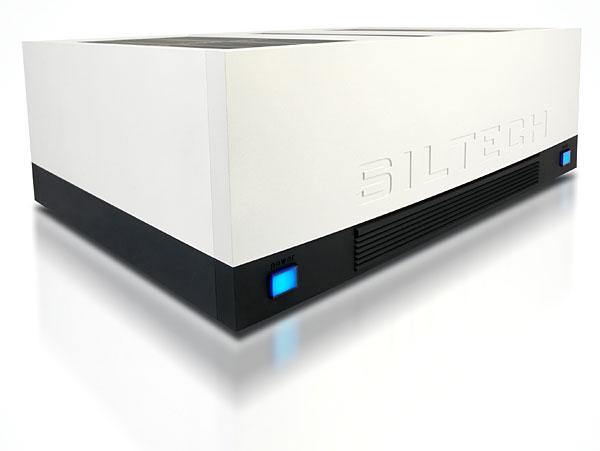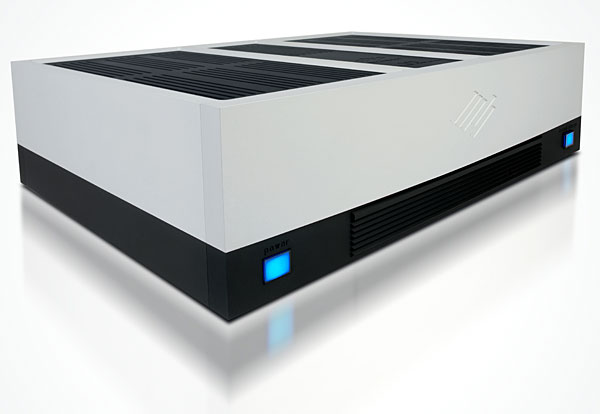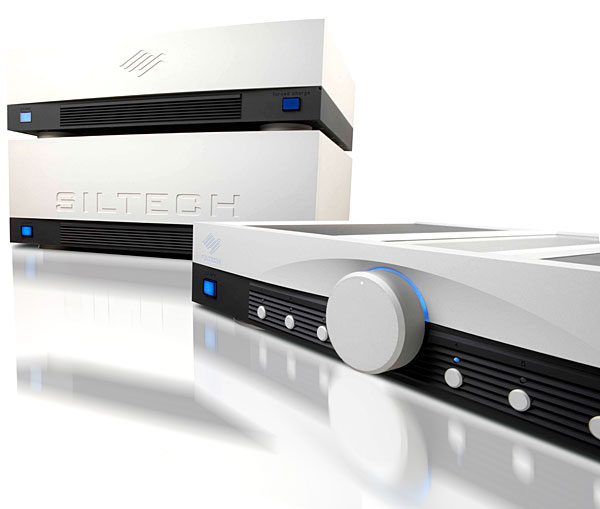| Columns Retired Columns & Blogs |
Siltech SAGA power amplifier

Among the biggest buzzes at the January 2013 Consumer Electronics Show, and at Munich's High End Show the following May, was the sound in the room of Siltech BV, a Dutch company best known for its high-end cables. Siltech was demonstrating an innovative new power amplifier, and using it to drive the company's glass-cabineted Arabesque loudspeakers ($90,000/pair). The sound was unmistakably lush yet also remarkably linear, notably dynamic, and seemingly free of electronic artifacts. It sounded like the sound of "nothing"—which was really something!—and so much of a something that it caught the attention of many reviewers. But while there's often controversy and disagreement about a given product's sound quality, this time the enthusiasm seemed unanimous.
What was responsible for the enticingly velvet sound? The speakers? The electronics? Both? It was impossible to know. (I later found out that the source component was an inexpensive CD player hanging off the back of Siltech's C1 preamplifier, so it wasn't that.) I quickly sought an explanation from Siltech's chief designer and CEO, Edwin Rynveld, who has a master's degree in electronics. He gave me a quick conceptual description of their unique Structural Amplifier Gain Architecture, which was used in the amp that we were hearing, which bears its acronym: SAGA.
Two Chassis, But Not Monoblocks
For the SAGA, Siltech's engineers chose to rethink the structure of amplifier gain. Though the SAGA has two cases, they are not monoblocks, nor are they of equal size. Each serves a different purpose, and both are required. One chassis contains the V1, a battery-powered, tubed, stereo voltage amplifier. In the other is the P1, a solid-state, mains-powered stereo current amplifier. That division of labor between two boxes is unusual, but even more so is the P1's Apollo Light Drive, a hermetically sealed box containing eye-searing, high-intensity LEDs shining on a solar panel that converts the light into current to power the amplifier's drive section. The P1 is thus galvanically isolated from the V1.

The V1 voltage amplifier employs a pair of E80CC new old stock (NOS) Telefunken or Philips dual-triode tubes made between 1953 and 1965. These low-noise, low-distortion devices were originally intended to be used in audio measuring devices, among other applications. Also included, and operating completely independently in its own circuit, are two low-noise, low-distortion Philips 18042 pentode tubes, originally made between 1947 and 1958 for use in industrial telephone amplifiers. A toggle switch on the V1's bottom plate lets you switch it between triode and pentode operation, though the switch is labeled simply High and Low Output.
The V1's tubes run on high DC voltage. According to the one-sheet supplied by Siltech, keeping the SAGA quiet required a fully shielded "virtually DC to DC converter" that produces noise-free 380V DC. A bipolar, emitter-follower voltage buffer after each tube stage in the V1 ensures low output impedance, to reduce cable-load effects while leaving the sound quality unaffected.
The V1's output plugs directly into the P1's input via singled-ended cables. The P1 doesn't have to also be a voltage amplifier—the V1 has that covered—so the P1's output voltage equals its input voltage, which, according to Siltech, helped simplify its design. The P1 can be seen as "the ultimate buffer stage between the amplified music and the loudspeaker."
The P1 works as a high-impedance emitter-follower without negative feedback, but to avoid crossover distortion, the bipolar transistors must be biased to mimic class-A behavior. That required the design of the special circuit that keeps the transistors operating "full on," even with difficult loads. The purpose of the Apollo Light Drive is to provide the current needed to bias the SAGA's output stage without its output being modulated by other circuit elements.
The V1 and P1 are each priced at $37,500, meaning that the complete SAGA two-channel amplifier costs $75,000. Its build quality and industrial design befit the price. Siltech hand-builds the SAGA in-house, and its construction looks seamless, with nary a screw or bolt in sight. The satiny finish, and everything else about the two chassis, exudes understated class. The more closely I examined the small details, the more I appreciated what I saw. The internal build quality, too, appears high, and all audio and power-supply wiring is Siltech's own expensive, large-gauge, pure-monocrystal silver S8. The SAGA's claimed power output is 380Wpc into 8 ohms, 760Wpc into 4 ohms, or 1250Wpc into 2 ohms, though these are not continuous ratings. Still, that's a lot of power.
Actually, a three-box system
Siltech intends the V1 and P1 to be paired with their C1 Control Amplifier ($37,500)—a tubed, battery-powered preamplifier. The C1 uses four NOS dual-triode tubes: low-supply-voltage ECC86s, a type once used in car radios, making it a good choice for a battery-powered preamp. The C1 has one balanced and five single-ended inputs, a preprogrammed Logitech Harmony 1100 remote controller for volume and source selection, and no tape loop.

Stereophile's policy is to review one component at a time, and my assignment was to review the power amp. However, because the SAGA is intended to be used as a three-box system, I listened to it three ways: with the C1, with my reference darTZeel NHB-18NS solid-state preamplifier, and driven directly by the dCS Vivaldi DAC's digital volume control.
Setup and Use
The V1's battery supply is good for 12–15 hours of continuous use, and throughout the review period, it never ran out of juice—not that that's a problem, as the V1 automatically switches to AC power as needed. Ditto the C1.
The source's output connects to the V1's input, and the V1's output goes to the P1. I used balanced connections for all combinations, except for single-ended between the darTZeel and the V1.
Throughout the two-month listening period, the SAGA system worked as advertised; battery operation was never a problem, and never required attention. The tubes are claimed to last 10,000 hours, with replacement suggested after 5000–8000 hours. The battery is claimed to last five to 10 years, though replacing it after five years is recommended for the best sound quality. Following the failure of the first two samples of the P1 and the first sample of the V1 on the test bench, I repeated my auditioning with additional samples after John Atkinson had finished his third round of measurements.
Unique Sound
My original question was answered in my first 10 minutes of listening to the original samples: It was the SAGA amplifier that had been responsible for a great deal of the sound I heard at CES and in Munich. With the SAGA installed in my system, the qualities I'd heard at both shows appeared in my listening room: a seamless, sonically air-tight sound with no obvious tonal colorations or other audible detritus, such as transients that were too sharp or too soft.
But, like every other audio product, the SAGA had a sound and a personality. Although that sound was as unique as its design architecture, overall it most reminded me of the sound of the Ypsilon Aelius ($36,000), another tube/solid-state hybrid, and one with a differently unique circuit topology.
Does different sound necessarily mean better sound? That judgment is yours to make. My job is to describe what I heard. Whether in triode or pentode mode, the SAGA delivered levels of sonic purity and background quiet that were unique in my listening experience. What's more, at both low and high SPLs, the SAGA maintained its composure.
Especially in pentode mode, but even in triode mode, compared to the darTZeel NHB-458 or D'Agostino Momentum monoblocks, not to mention the Lamm ML-3s, the SAGA sounded as if it had tightened the turnbuckles of tonality, space, and, especially, rhythm'n'pace—the sound was positively exhilarating. This all resulted, I figure, from the amp's ironfisted grip on the speakers. The SAGA managed a seamless, top-to-bottom grip on my Wilson Audio Specialties Alexandria XLF speakers that produced a taut bottom-to-top transient response and an overall speed reminiscent of the Soulution 710 stereo amplifier ($50,000) I reviewed in the August 2011 issue. But musical events had more staying power—as if the SAGA were lingering longer on them instead of too quickly rushing to the next—and the harmonic structures of instruments were far more impressively reproduced, despite the clarity and speed. Perhaps the positive influence of the tubes . . . ?
But such turnbuckling has inevitable downsides: Soundstage depth was somewhat foreshortened, with images between the speakers that normally appear well behind the speaker plane presenting themselves closer to a line drawn between them.
- Log in or register to post comments



































